
Scan this QR code to see all WCC 2023 games online!
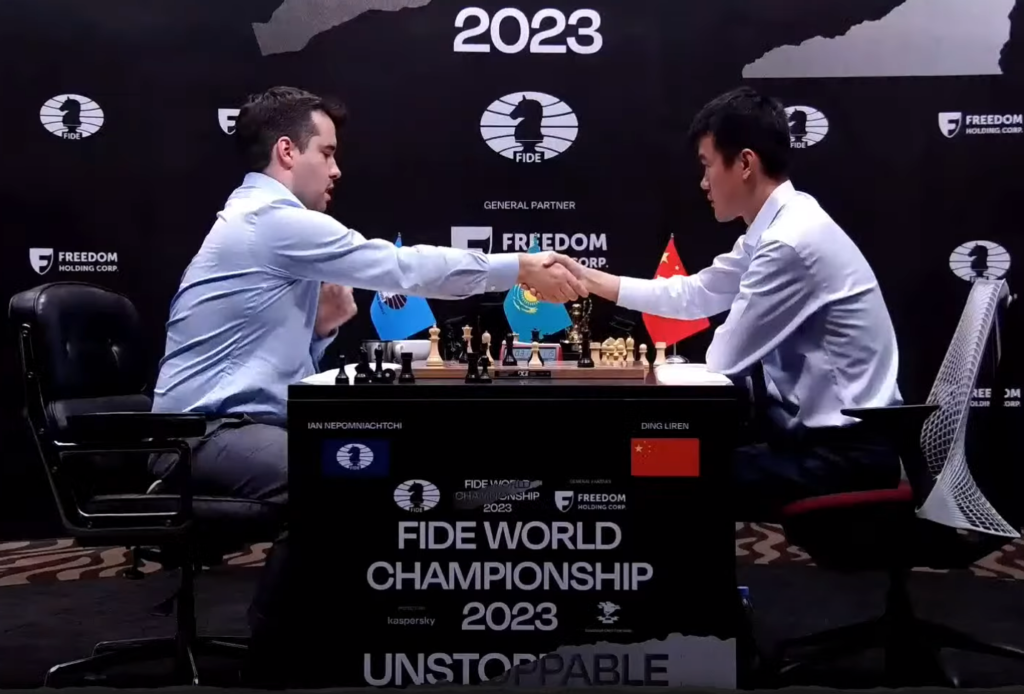
On April 9, 2023, the World Chess Championship (WCC) began in Astana, Kazakhstan. Ding Liren of China and Ian Nepomniachtchi of Russia competed in a 14-game classical match, and then a four-game rapid tiebreaker for the title of World Chess Champion. Magnus Carlsen (the five-time champion from 2013-2023) chose not to defend his title, and had previously beaten Nepomniachtchi in the 2021 WCC.
In each game, the players began with two hours on their clock. After forty moves had been played by each side, the players gained an additional hour, and after sixty moves, they gained fifteen minutes as well as an additional thirty seconds for each move that they subsequently played. Although this is a lot of time, the clock played a key role in several matches. A victory for either player would reward them with 1 point, and a draw would grant each player 0.5. Since the WCC is a 14-game match, each player could win at any time by reaching 7.5 points.
This article will describe moves with algebraic notation. If you’re new to the system, you can find information on chess.com or other online resources.
Game 1
April 9, 2023
Ian Nepomniachtchi – Ding Liren
½ – ½

WCC Game 1 position after move 28. Chess.com
Nepomniachtchi surprised everyone with the white pieces in the very first game with an unusual variation of the Ruy Lopez opening, in which after 3… a6, White plays 4. Ba4, refusing to trade their bishop for Black’s knight on c6, but later changes their mind and plays 6. Bxc6. The position before White’s 6th move has been reached by titled players hundreds of thousands of times, and 6. Bxc6 was played in less than 5 percent of those games. This move is objectively not very good, and Nepomniachtchi knew it, but its main purpose was to reach positions that Ding was not prepared for. Indeed, Nepomniachtchi gained a significant time advantage after the opening.
Nepomniachtchi was able to infiltrate the Black position with his queen, but even with only thirteen minutes on his clock, Ding found the right moves to defend himself. In this position, Nepomniachtchi should have played 29. Bc7 and went for Black’s a5 pawn, but instead tried to cash in too greedily with Bd6!?, which soon allowed Black to threaten an infiltration of the White position and force a queen trade, resulting in an eventual draw.
Game 2
April 10, 2023
Ding Liren – Ian Nepomniachtchi
0 – 1
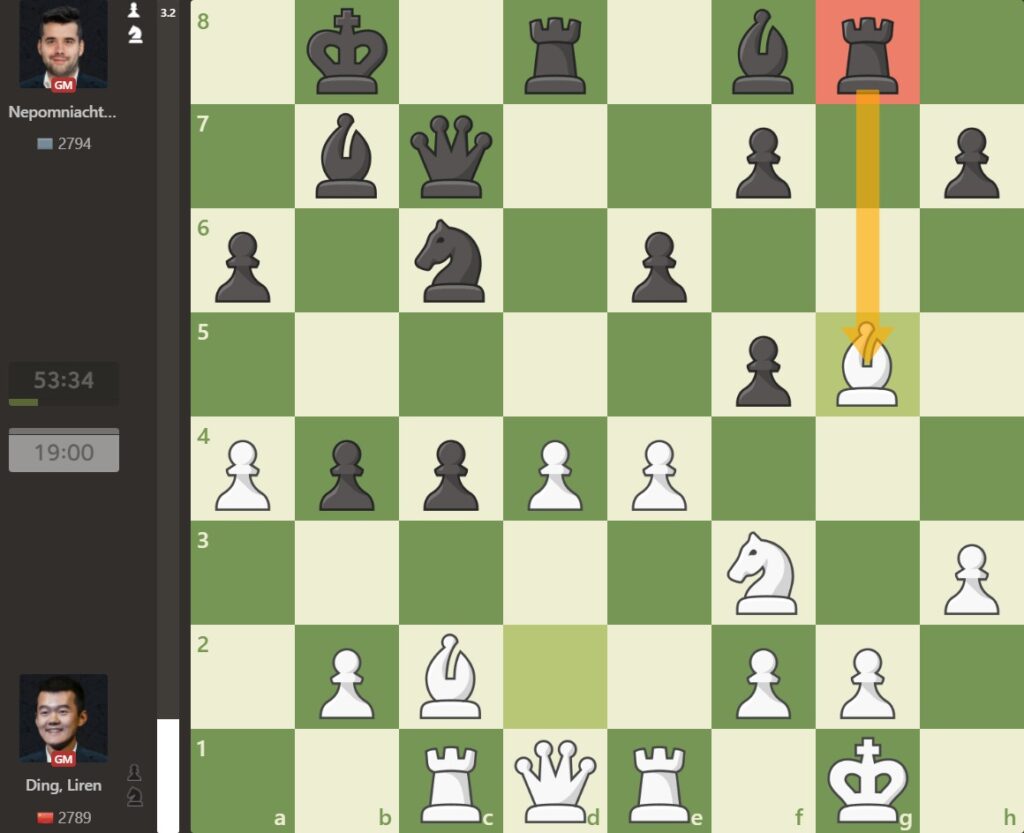
In the opening of Game 2, Ding with the white pieces clearly out-prepared Nepomniachtchi, and secured a 30-minute time advantage. However, after Nepomniachtchi played an unconventional knight move 11… Na5, Ding thought for thirty-three minutes and played a slight inaccuracy. Soon after, Nepomniachtchi created a very powerful attack (despite playing a move behind due to starting with Black) and pressured Ding into a 30-minute time disadvantage with a significantly worse position. When Ding tried to create counterplay on move 20, Nepomniachtchi sacrificed the rook! 20… Rxg5! 21. Nxg5 allowed Nepomniachtchi to play 21… Nxd4. Soon after, he was able to create a passed pawn and threaten promotion, and Ding resigned.
In Game 3, which was a Queen’s Gambit Declined: Exchange Variation, Nepomniachtchi did not manage to create any winning chances with white, and the game ended after 30 moves with a draw by threefold repetition.
Game 4
April 13, 2023
Ding Liren – Ian Nepomniachtchi
1 – 0
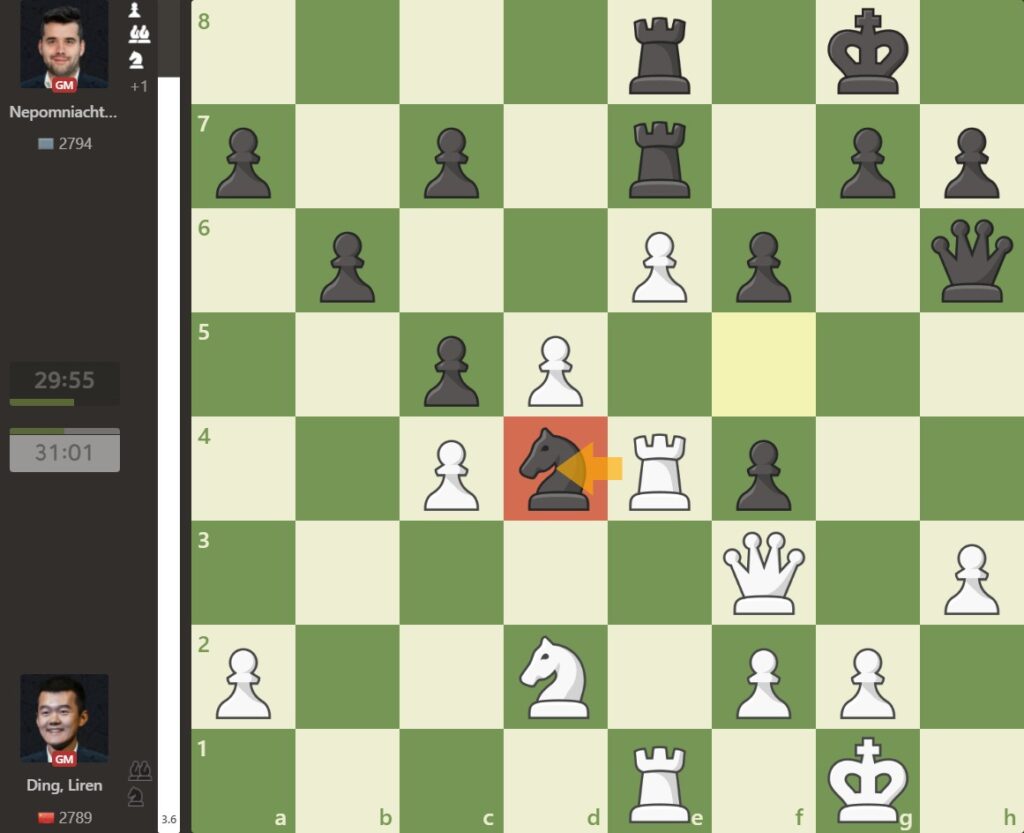
Beginning with an English opening, this game was a spectacle. Ding won the opening battle and secured a very strong center, later sacrificing one of his pawns to create the pawn chain shown in the pictured position. Nepomniachtchi presumably played 28… Nd4 expecting Qxf4 Qxf4 Rxf4 and then possibly c6. Ding instead decided to sacrifice with 29. Rxd4!! which was followed by cxd4 Nb3 and a subsequent steamrolling of the position as Ding navigated his knight to d4 and then to f5. Soon after, Ding won back an exchange when Nepomniachtchi was forced to allow a fork, and then Nepomniachtchi resigned.
Game 5
April 15, 2023
Ian Nepomniachtchi – Ding Liren
1 – 0
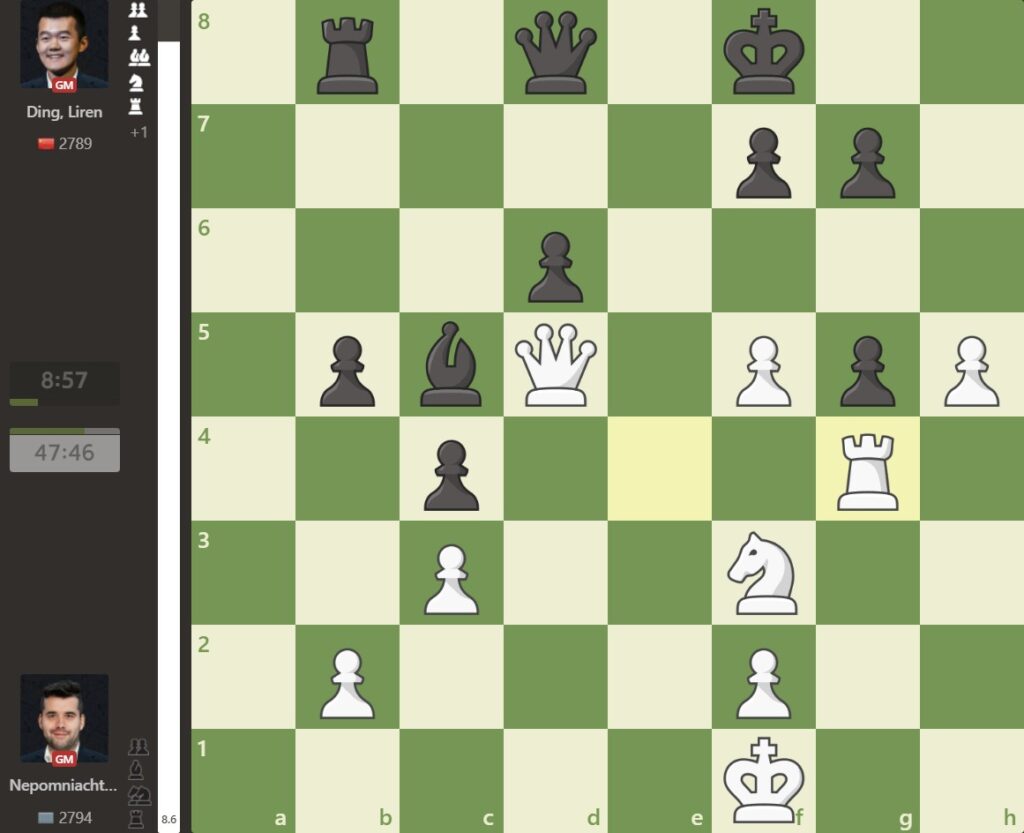
Nepomniachtchi won game 5 with the Anti-Marshall variation of the Ruy Lopez opening. After securing a 40-minute time advantage in the opening with excellent preparation, he created a powerful attack. After Ding played 37… hxg5, Nepomniachtchi played Rg4! as pictured. This threatened to play Nxg5 with a checkmate threat on f7, and if Ding had played 38… f6, Nepomniachtchi prepared the move Nh4!!. His idea here is that if Ding didn’t take, he could play Ng6+ with mate in 3, but if he did, then h6! would either lead to checkmate or a promotion. Ding instead continued with 38… Ra8, which eventually led to a position where it was impossible to prevent promotion, and he resigned. For the second time in the match, Nepomniachtchi led by one game.
Game 6
April 16, 2023
Ding Liren – Ian Nepomniachtchi
1 – 0
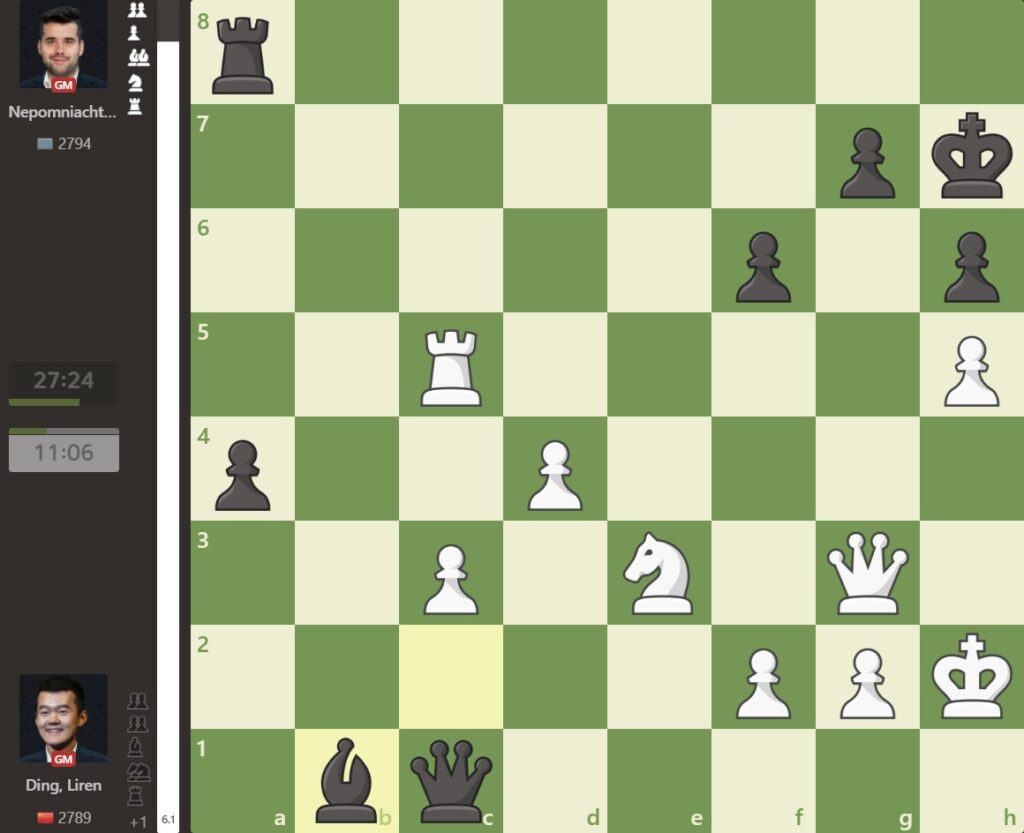
Ding opened game 6 with the London system and proceeded to reach the pictured position. White is creating a huge threat to Black’s king, while Black is attempting to promote their passed a4 pawn. Ding found a key sequence here: 37. Rc7, threatening checkmate, which forces Black to play Rg8, which allows Ra7, defending the A file. With the threat of promotion temporarily stalled, he was able to line up his queen and knight against the Black king, resulting in Nepomniachtchi’s resignation.
Game 7
April 18, 2023
Ian Nepomniachtchi – Ding Liren
1 – 0
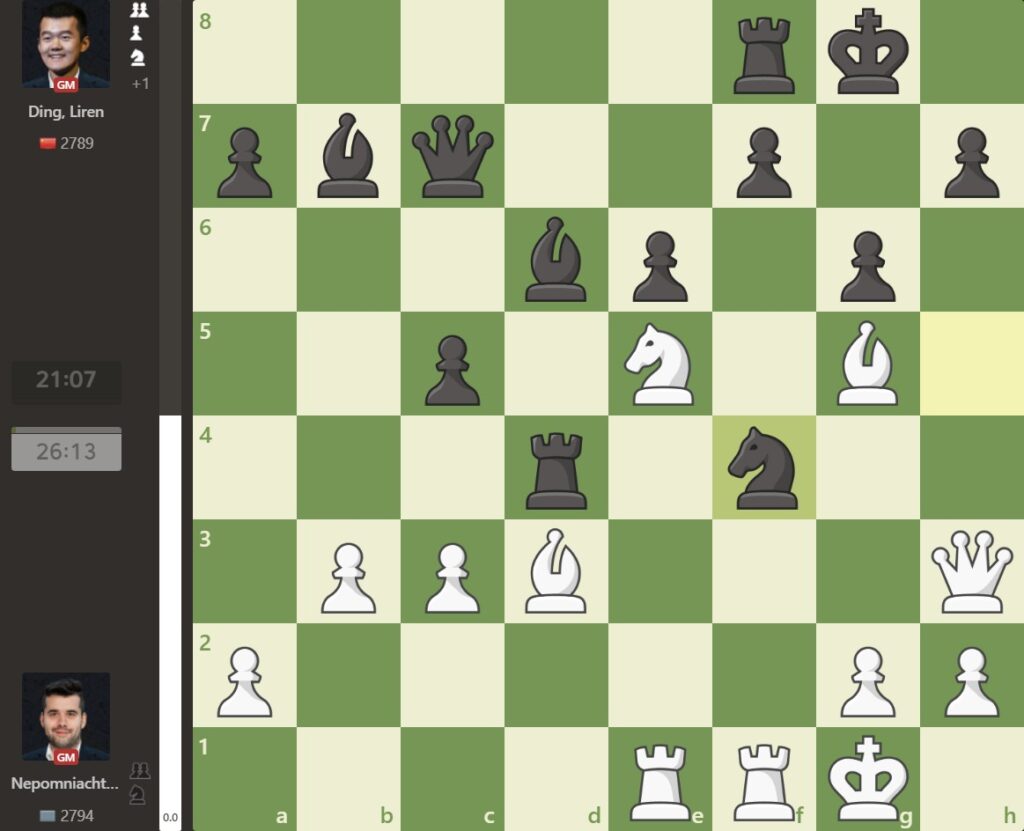
Ding surprised everyone on the very first move of game 7 by responding to 1. e4 with 1… e6, the French defense. The French is much less popular now than in the past because modern computer analysis indicates that it is not viable at the super-Grandmaster level.
The pictured position has an endless number of tactical possibilities in it as White threatens an attack on Black’s king and Black threatens a devastating infiltration. It is a very tough position to calculate, and both players had only twenty minutes on their clocks. They were also far from hitting move 40, which would have granted the players an additional hour each. Ding found a promising sequence, and despite being down an exchange, he had very reasonable winning chances by move 32 with five minutes on his clock. Then he froze.
Many commentators were in visible pain watching Ding’s time tick down. Many thought this was the end for him, that he wouldn’t recover from not only this position, but from this game. From a hard-fought and potentially winning position, Ding spent all but forty-five seconds and played a mistake. 32… Rd2 was not the right idea. It didn’t lose on its own, but panicking did. He resigned a few moves later in a completely lost position. For the third time, Nepomniachtchi was winning by one point.
Game 8
April 20, 2023
Ding Liren – Ian Nepomniachtchi
½ – ½
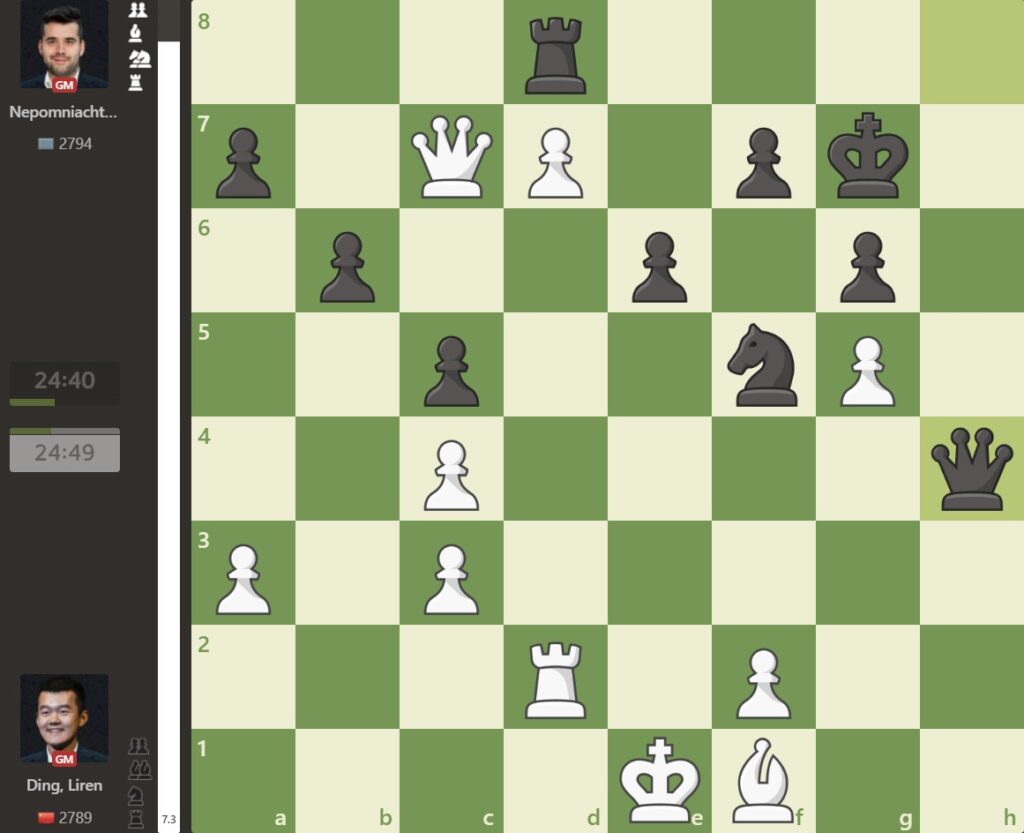
In this Nimzo-Indian Defense game, Ding reached an almost completely winning position after his move 31. Nepomniachtchi’s move, 31… Qh4??, was a bluff, and Ding fell for it. Nepomniachtchi’s move looks like it simply blunders the rook on d8, and it does, but it gets complicated for White if they take it. Qxd8 allows Qe4+, and if White blocks with their bishop, Black has Qh1+, forcing the bishop back, and threatening a draw by repetition. White will soon have to block the check with Re2, which allows Qb1+, skewering White’s king and bishop. To avoid repetition by perpetual check, White will soon have to walk their king all the way to e4, and it’s a miracle that there’s no forced draw or checkmate. Ding was too low on time and didn’t calculate these lines in their entirety, and played 32. Kd1. He could have later won with a brilliant tactic, but missed it, and the game simplified to a drawn endgame.
Soon after the start of game 8, a Reddit post identified two Lichess.org accounts that had played several games against each other that very closely followed those in the WCC. The user correctly speculated that these were accounts used by Ding and his training partner, Richard Rapport, to prepare for the WCC. Commentators saw it as extremely irresponsible that Ding had trained using Lichess, as it stores all games played on it in a database accessible to anyone. This was a problem because Nepomniachtchi’s team was able to prepare against everything that Ding had played on this account. At the time, Nepomniachtchi responded to the leak by saying “I am still more or less doing what I was going to do.” However, after the event, Ding revealed that he “realized it left [them] with no real ideas, so [they] had to come up with new ones” during the match.
Games 9, 10, and 11 were all draws in which neither player ever had a much better position than the other. They were incredible games, of course, but not as exciting as many of the first few. Commentators thought that Ding was unlikely to make a comeback.
Game 12
April 26, 2023
Ding Liren – Ian Nepomniachtchi
1 – 0
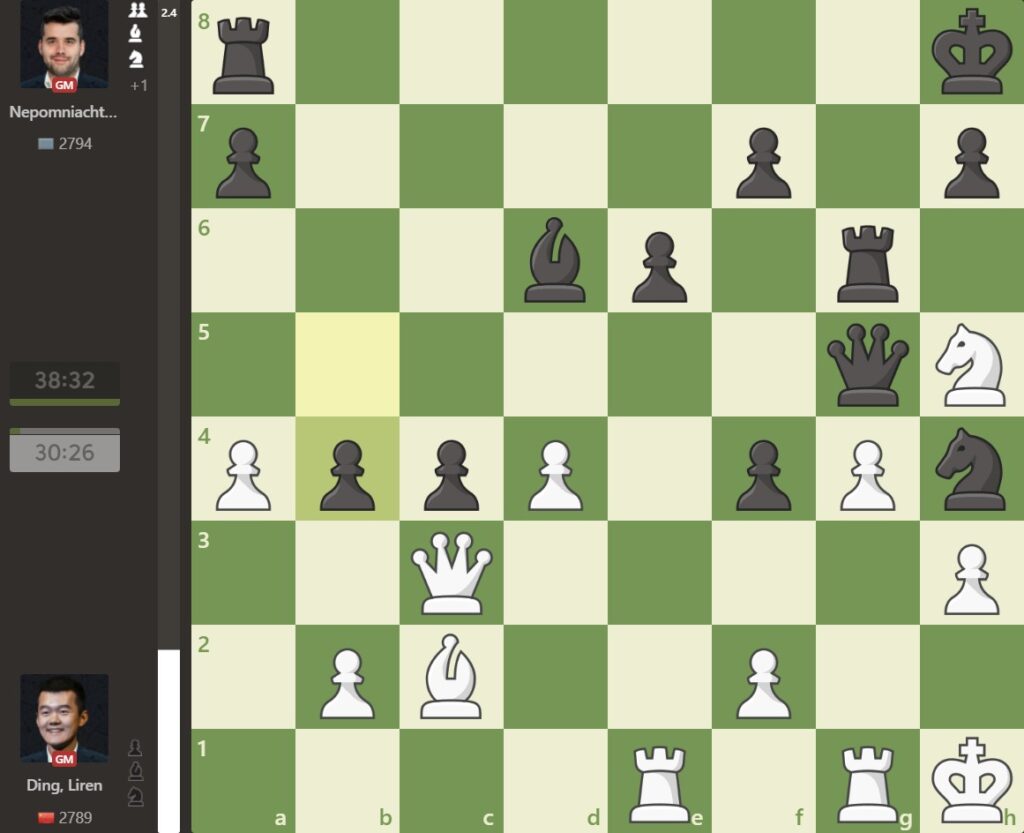
Ding opened game 12 with the Colle system. If the reader has never heard of it, that’s because it’s a very unusual opening that does not seem to play for an advantage. Nepomniachtchi later invited a doubling of his pawns on his castled kingside, moving his king to h8 and rook to g8 to boost his own kingside attack. Ding’s moves were not working out, and he was worse by move 20.
Nepomniachtchi, seemingly trying to play Nf3 with a fork on Ding’s rooks, smoked the White queen away from the defense of the f3 square with 27… b4. However, when Ding took with Qxc4, Nepomniachtchi rather played Rag8?, trying to remove any possible threats on his king. Nf3 was the best move, and maybe he didn’t like it because of Qc6, with a triple fork on Black’s knight, bishop, and rook. After Rag8, the game continued with 28. Qc6? Bb8?, and Ding’s best move was Bxg6. Taking the rook doesn’t actually win material, though, because the resulting hxg6 traps White’s knight. It was the best move, though, because after hxg6, the move d5 becomes very strong. If Black were to take with exd5 or play e5, White would play Nf6 and end up winning material by threatening Black’s king. If Black instead were to ignore the threat with something like Be5, White could take dxe6 and after fxe6 play Qxe6. Black’s best move was Qxd5, but after the resulting queen trade, Nf6 was still very strong for White.
None of that happened. Instead, the game was decided when Nepomniachtchi played an egregious blunder on move 34. Commentators were stunned. The move 34… f5?? was unimaginable for a player of Nepomniachtchi’s caliber. It’s so trivially a blunder, in fact, that this article won’t even cover the details. Blundering with sufficient time on the clock is how Nepomniachtchi lost against Magnus Carlsen in the 2021 WCC. The score was tied.
For brevity, this article will also skip games 13 and 14. Although they were also excellent games, they don’t contribute very much to the narrative. Since the score was tied after all fourteen Classical games, the players began a four-game Rapid tiebreaker match, with twenty-five minutes for each player and a ten-second time increment. The first three Rapid games were all draws, and if the fourth would have been a draw, then the players would have continued with a Blitz tiebreaker with a 5+3 time format. Instead, this happened.
Game 18
April 30, 2023
Ian Nepomniachtchi – Ding Liren
0 – 1
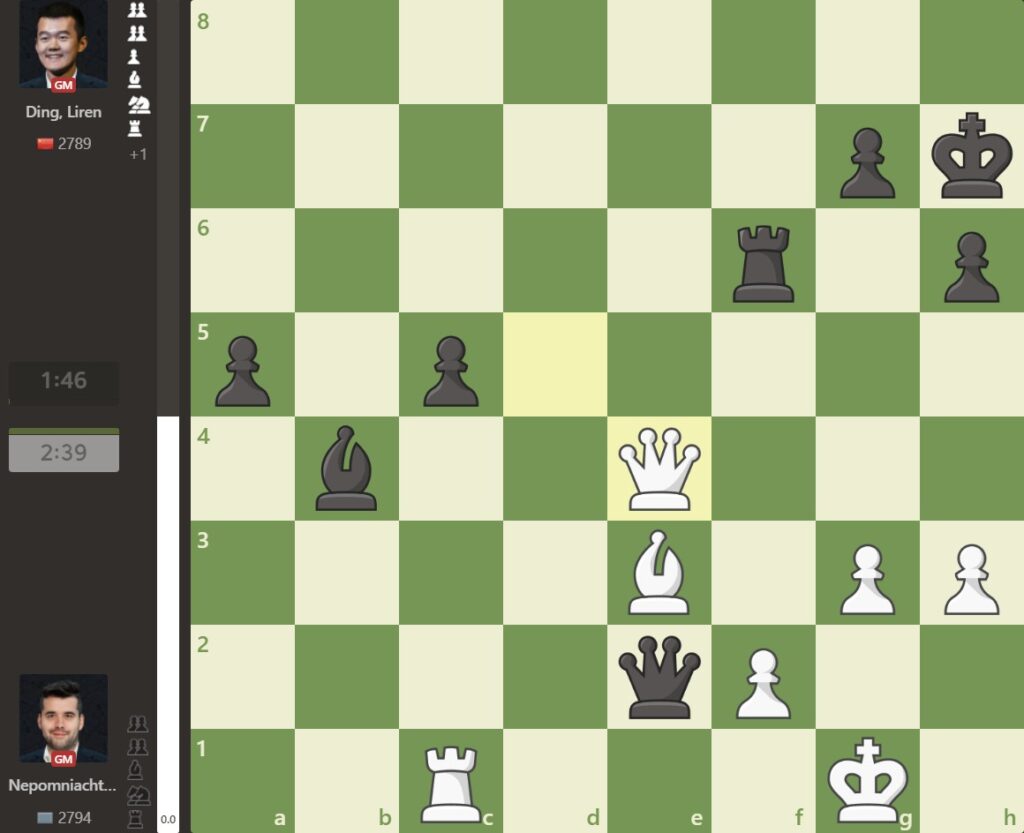
The players began the game with a Ruy Lopez opening line that was very similar to what they had played in some previous games. Nepomniachtchi played several very advanced moves that didn’t work out very well, including some that got his light-squared bishop stuck on b1 behind pawns on c2 and b3. By move 44, it looked like Nepomniachtchi would secure a draw by repetition as pictured, with Qe4+ Kg8 Qe8+ Kh7 and repeat. It also seemed like Ding would accept the draw, given that he was down a minute on the clock and it was a rather complicated position. However, after one repetition, Ding played the move heard around the world. 46… Rg6. He was playing for a win. Soon after, Nepomniachtchi’s minute of time advantage turned into a minute of time disadvantage. He played several mistakes. It was simply too hard to stop Ding’s pawn avalanche on the queenside.
Ian Nepomniachtchi took a long look at the trophy, accidentally knocked one of his captured knights off of the table, and resigned game 18 and the World Chess Championship to Ding.
Ding Liren’s journey was incredible. Usually, the two Chess World Championship contenders are the previous championship’s winner and the winner of the FIDE Candidates tournament. However, Ding did not meet any of the requirements that would have qualified him for the Candidates. Luckily for Ding, though, Russia invaded Ukraine. Sergey Karjakin, a Russian chess Grandmaster and to-be Candidates contender, said some very unsavory things in support of Putin and the invasion. FIDE made the decision to temporarily ban Karjakin from events out of respect for Ukraine, and Ding was brought in as a backup player because he held the highest Classical rating of all other players.
Then, Ding’s visa was denied. One might think that China would take extra care to make sure their top player could participate, but apparently that somehow wasn’t a priority. Ding fought, and eventually, with little time left, got his visa approved and was able to participate.
Ding’s start to the Candidates was not winner-strength. He lost his first game against Nepomniachtchi and tied the next seven, with 3.5/8 points. Meanwhile, Nepomniachtchi won four games with 6/8 points and Fabiano Caruana had 5/8. Miraculously, though, Ding was able to win four out of the last six games with one loss while Caruana trailed. Ding finished in second place. Then, Magnus Carlsen refused to defend his title and Ding was promoted to World Championship contender. And after all that, after being down 1 point on three separate occasions in the WCC, after winning the Rapid tiebreakers, Ding became the first Chinese Chess World Champion.
